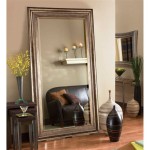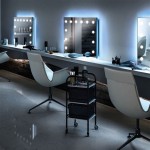How to Make a Wall Mirror
Wall mirrors are a versatile and stylish addition to any home. They can create the illusion of more space, brighten up a room, and serve as a decorative focal point. While you can purchase wall mirrors readily, creating your own offers a unique and personalized touch. This article will guide you through the process of making a wall mirror, from gathering materials to finishing touches, providing you with the knowledge and steps needed to design a beautiful and functional piece of art.
Choosing Materials and Tools
The first step in making a wall mirror is to gather your materials and tools. Here's a comprehensive list to ensure you have everything you need:
- Mirror: Choose a mirror that complements the size and style of the space where you plan to hang it. Consider the shape, size, and frameless or framed options.
- Mirror adhesive: This specialized glue ensures a strong bond between the mirror and the backing surface. Choose a type designed for mirror applications and follow the manufacturer's instructions for proper application.
- Backing material: This serves as the base for the mirror and provides structural support. You can use plywood, MDF board, or even a piece of scrap wood.
- Frame (optional): If you want to add a decorative element, choose a frame that complements the mirror and your desired style. Frames can be made from wood, metal, or other materials.
- Hardware (optional): This includes hooks, D-rings, or other fastening materials depending on your chosen hanging method.
- Measuring tape: Essential for precise measurements of the mirror and backing material.
- Level: Ensures that your mirror hangs straight and evenly on the wall.
- Saw (optional): If you need to cut the backing material to size.
- Scissors or utility knife: For cutting materials, if necessary.
- Pencil or marker: For marking measurements and outlines.
- Sandpaper (optional): For smoothing any rough edges on the backing material.
- Paint and brushes (optional): For customizing the look of the frame or backing material.
Constructing the Base
Once you have all the necessary materials, begin by constructing the base for your mirror. This step involves preparing and cutting the backing material to the desired size.
- Measure the mirror: Carefully measure the dimensions of your chosen mirror, making sure to record both length and width.
- Cut the backing material: Using a saw, cut the backing material to the desired size, ensuring it is slightly larger than the mirror to allow for a border. This border will help to secure the mirror and conceal the adhesive.
- Prepare the backing material: If needed, sand the edges of the backing material for a smooth finish. If you plan to paint the base, apply a coat of primer for better paint adhesion.
Attaching the Mirror
After preparing the base, you can attach the mirror to the backing material. This step requires careful application of the mirror adhesive to ensure a strong bond.
- Apply adhesive: Apply a generous bead of mirror adhesive around the perimeter of the back of the mirror. Make sure to distribute the adhesive evenly, avoiding any clumps or uneven areas.
- Position the mirror: Carefully center the mirror on the backing material, ensuring it is level and straight. Gently press down on the mirror to create a secure bond.
- Clamp the mirror: Use clamps to hold the mirror in place while the adhesive dries. Ensure the clamps are distributed evenly around the mirror to avoid uneven pressure.
- Allow time to dry: Follow the manufacturer's instructions for the adhesive drying time. This can range from a few hours to overnight, depending on the type of adhesive used.
Adding Finishing Touches
After the mirror is securely attached to the backing, you can add finishing touches to enhance its appearance and functionality.
- Install a frame (optional): If you chose to use a frame, carefully attach it to the mirror using wood glue or other suitable adhesive. Ensure a proper fit and secure bond before allowing the adhesive to dry.
- Attach hardware (optional): Select the desired hanging method for your mirror, whether it be hooks, D-rings, or other hardware. Attach the hardware to the back of the mirror or the frame, ensuring it is secure and can support the weight of the mirror.
- Clean the mirror: Use a clean microfiber cloth and a mild glass cleaner to remove any residue or fingerprints from the mirror surface. This will ensure your mirror looks its best.
Hanging Your Wall Mirror
Once the finishing touches are completed, you are ready to hang your handmade wall mirror. This step requires careful positioning and secure hanging, ensuring that your mirror remains safe and stable.
- Select a hanging location: Choose a spot on the wall where you want to hang your mirror. Consider the height, lighting, and surrounding furniture to achieve a balanced and aesthetically pleasing arrangement.
- Mark the hanging point: Use a level to mark the desired location for your mirror on the wall. Make sure to account for the weight of the mirror and the chosen hardware when selecting the appropriate wall anchors or screws for secure hanging.
- Hang the mirror: Carefully align the mirror with the marked location and use screws or nails to secure the hardware to the wall. Ensure a firm and secure hold to prevent the mirror from falling.
- Adjust and admire: Take a step back and admire your newly created wall mirror. Make any minor adjustments to ensure the mirror is properly hanging and centered before stepping back to enjoy your handcrafted masterpiece.

Diy Mirror Wall Easy

How To Make A Mirror Wall Step By Guide

How To Make A Mirror Gallery Wall

Diy Wall Mirrors Thirty Best Home Decor Projects

Diy Wall Mirrors Thirty Best Home Decor Projects

How To Make A Large Arched Mirror Jenna Sue Design

How To Build An Accent Mirror Wall Diy Steps

How To Make A Mirror Color Blocked Diy

How To Make A Mirror Wall For Your Home Gym

Diy Large Paneled Wall Mirror Shanty 2 Chic








